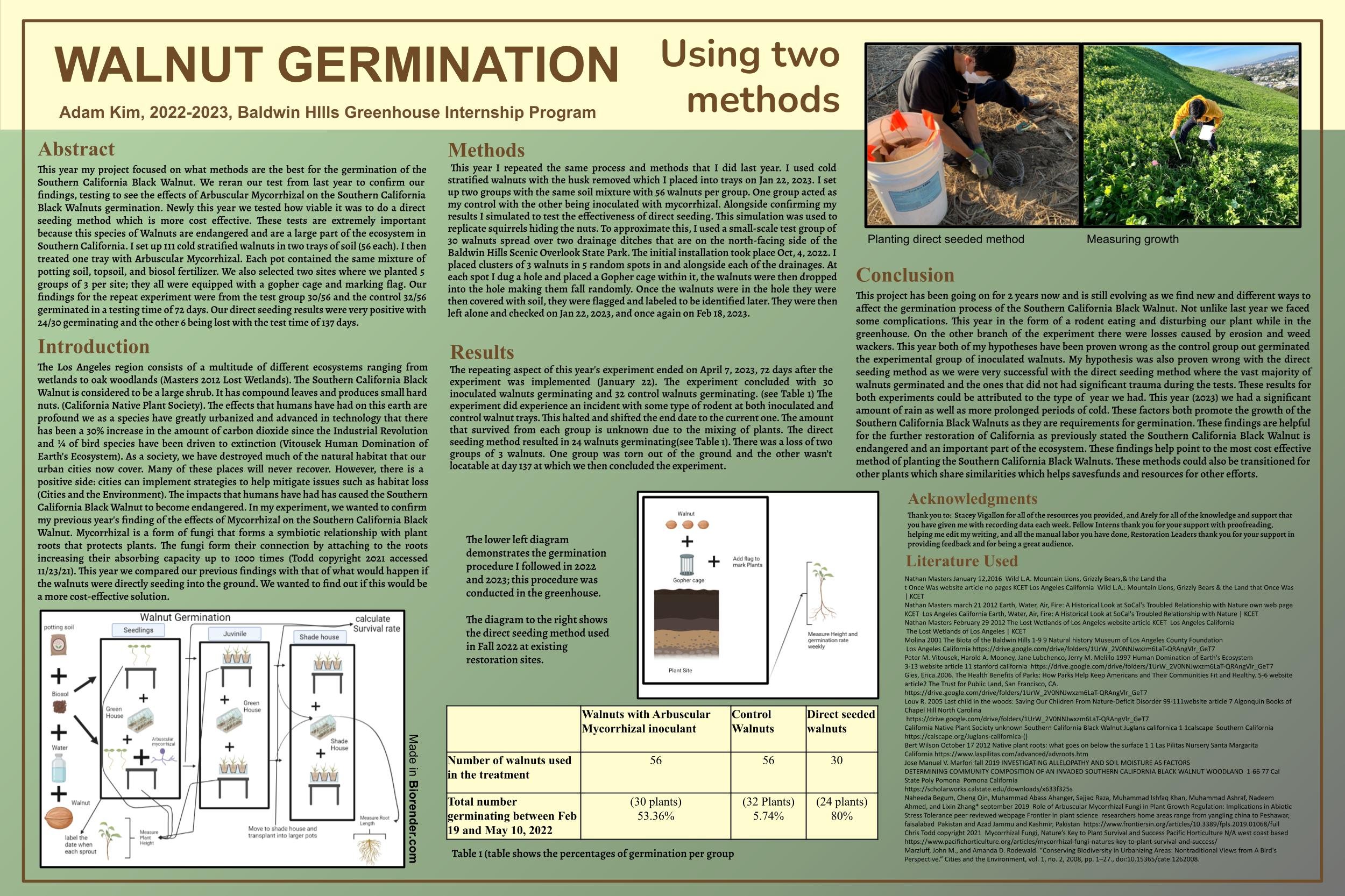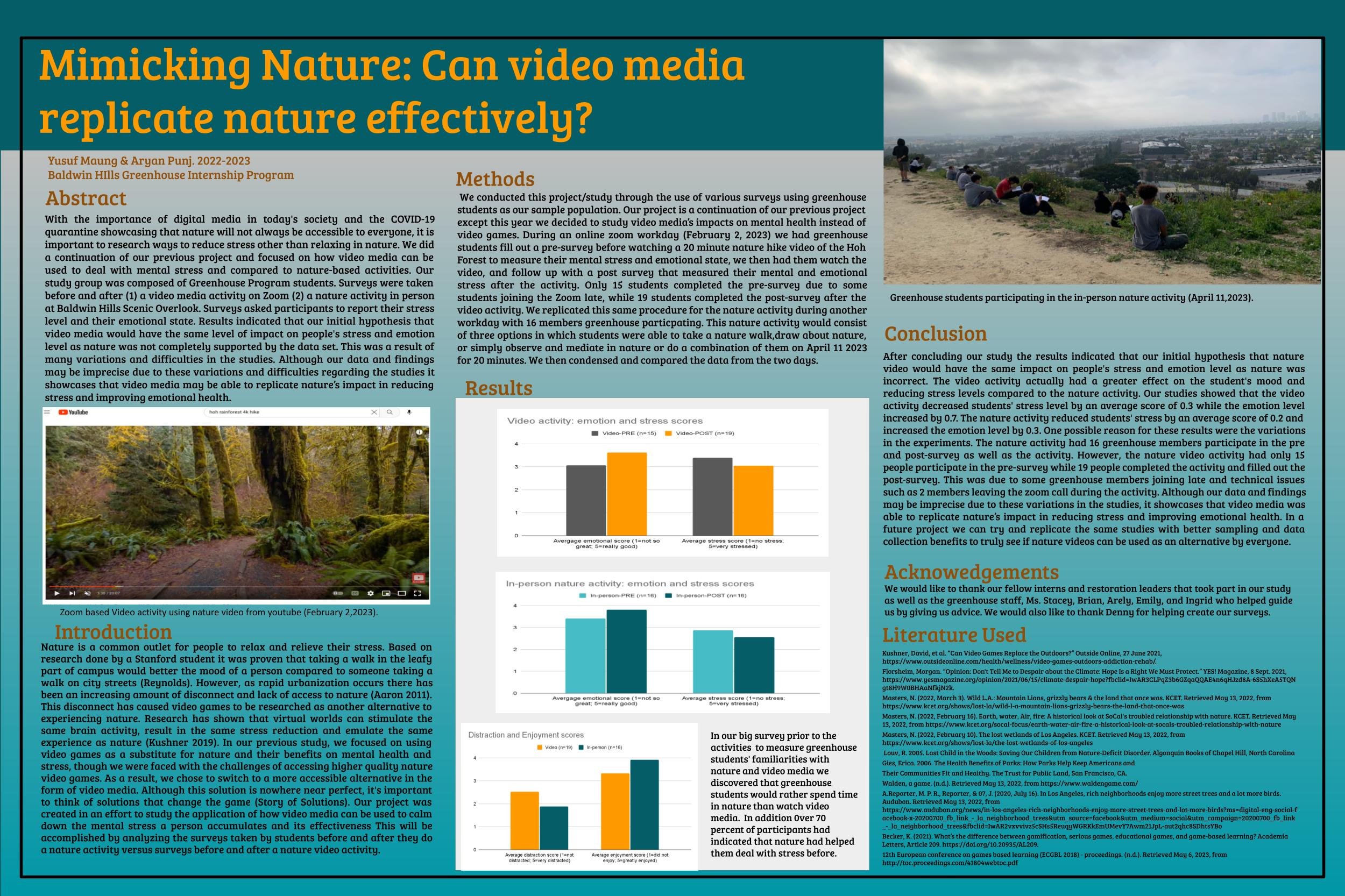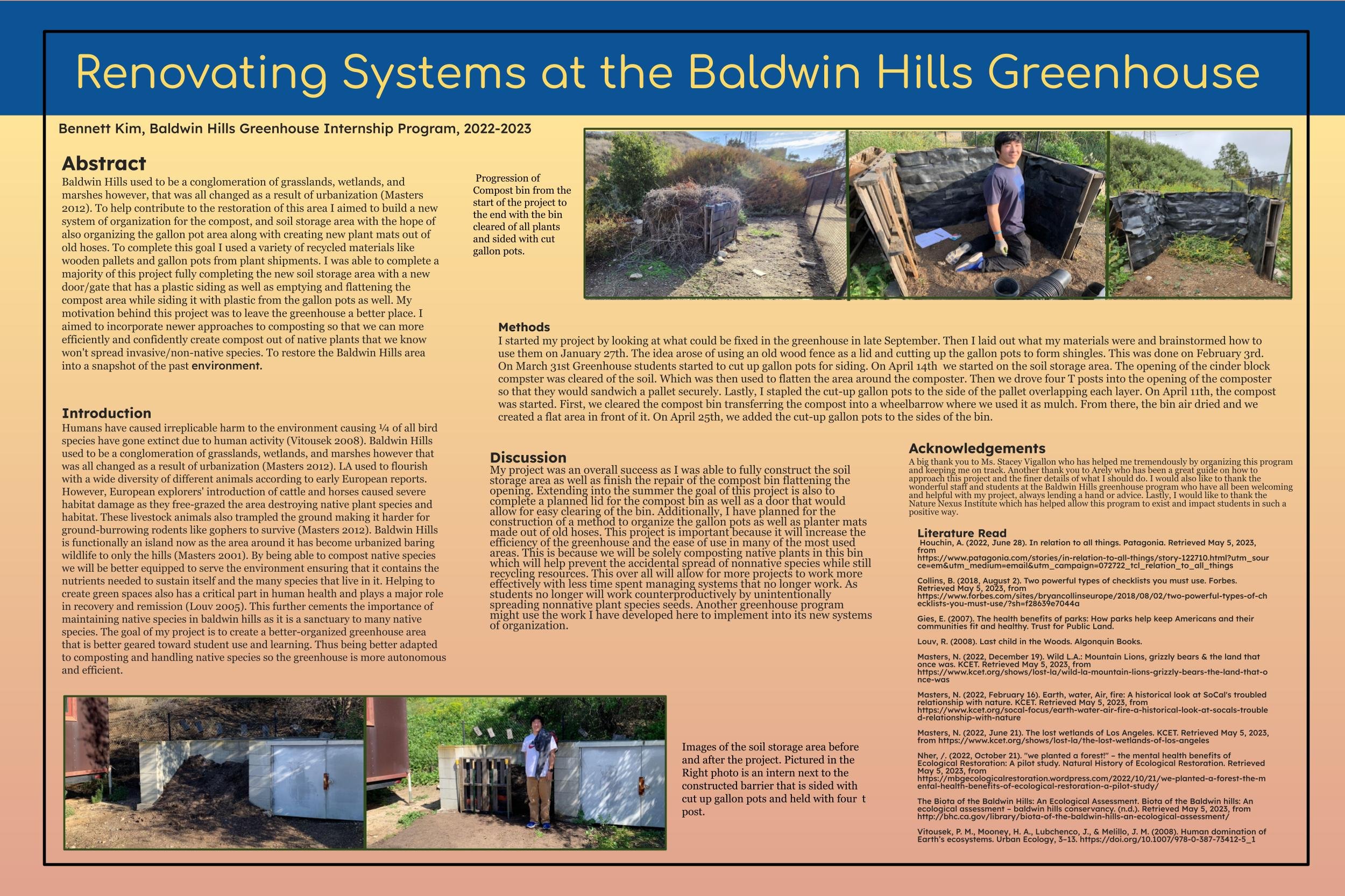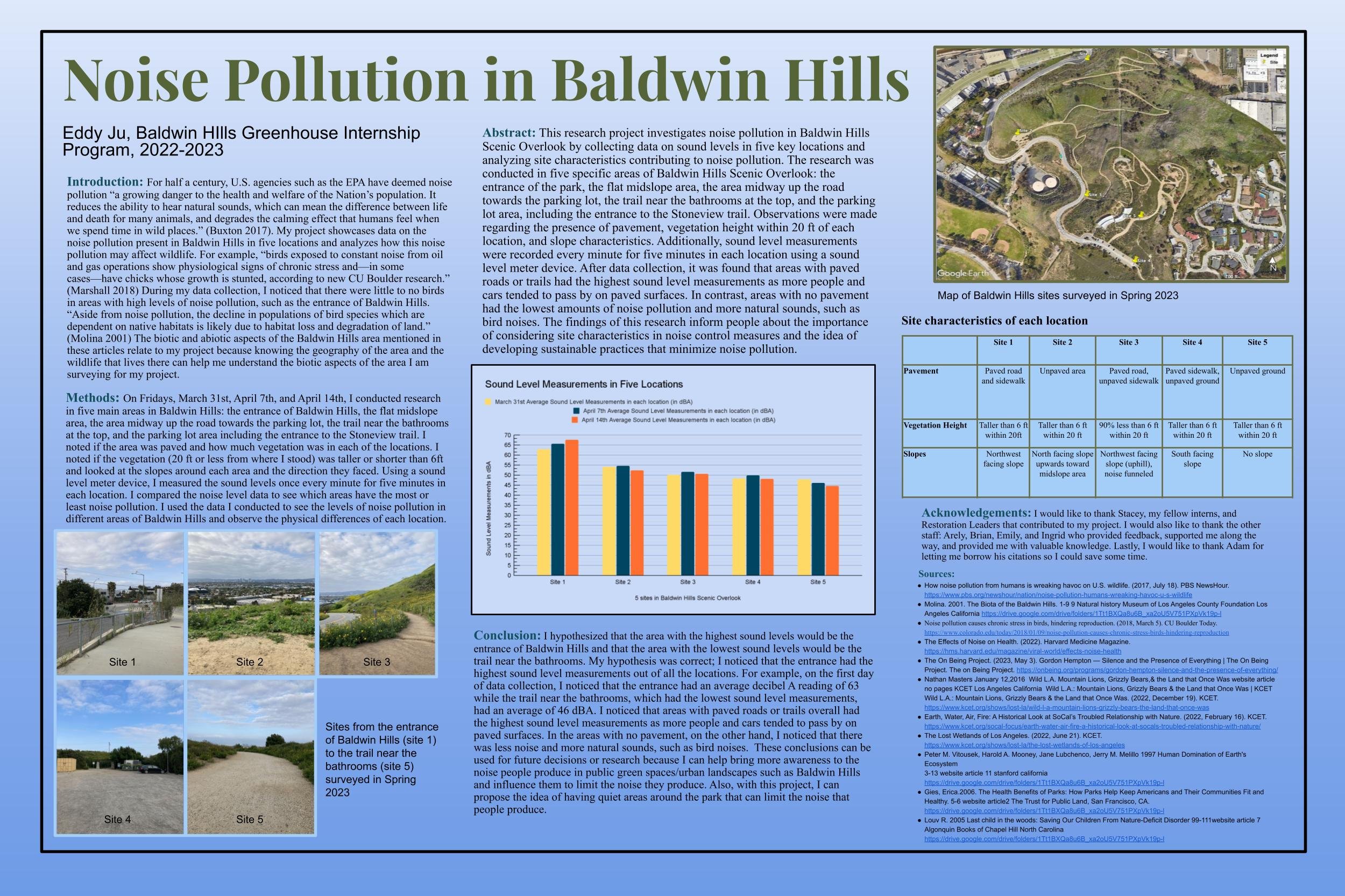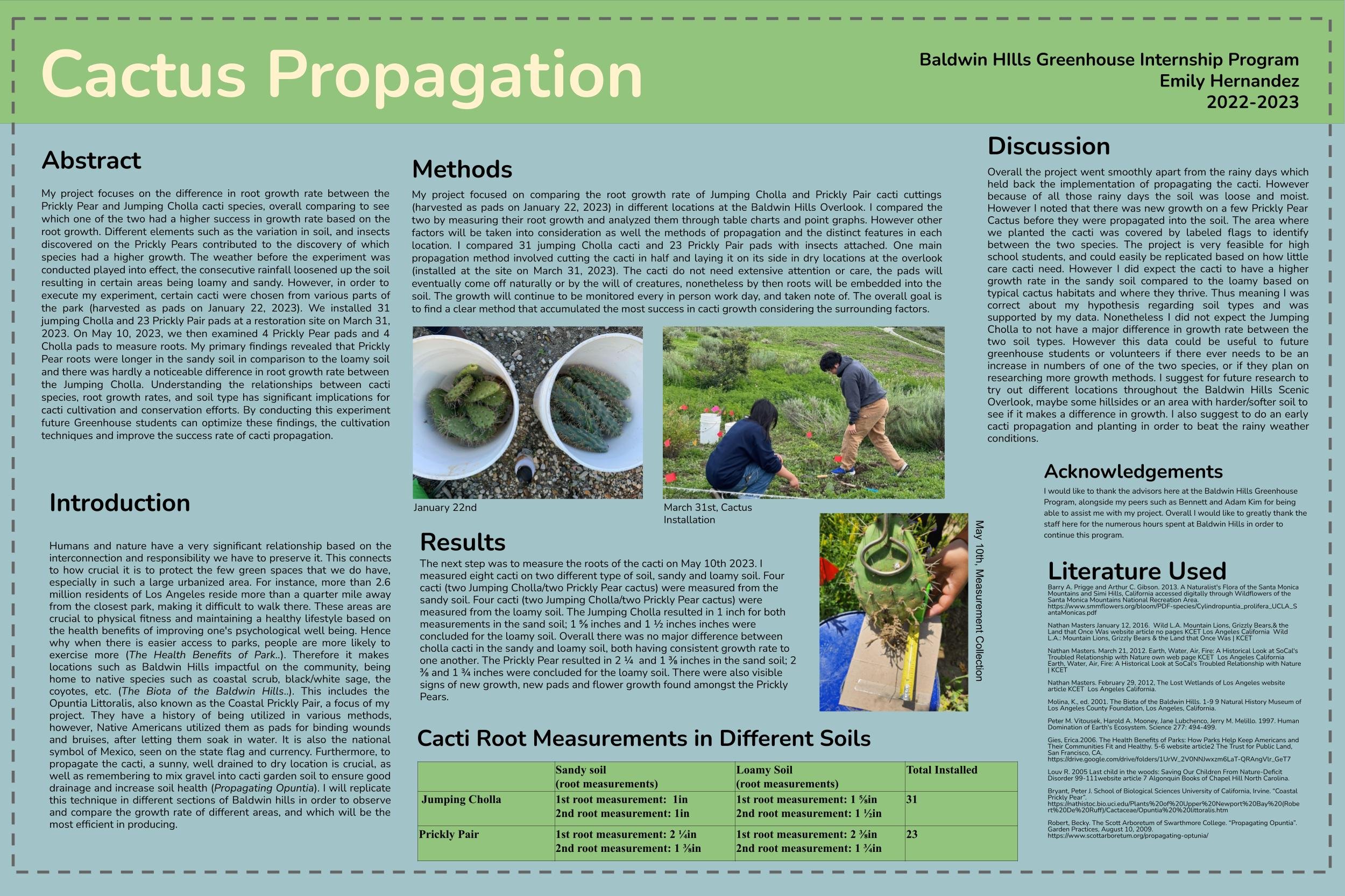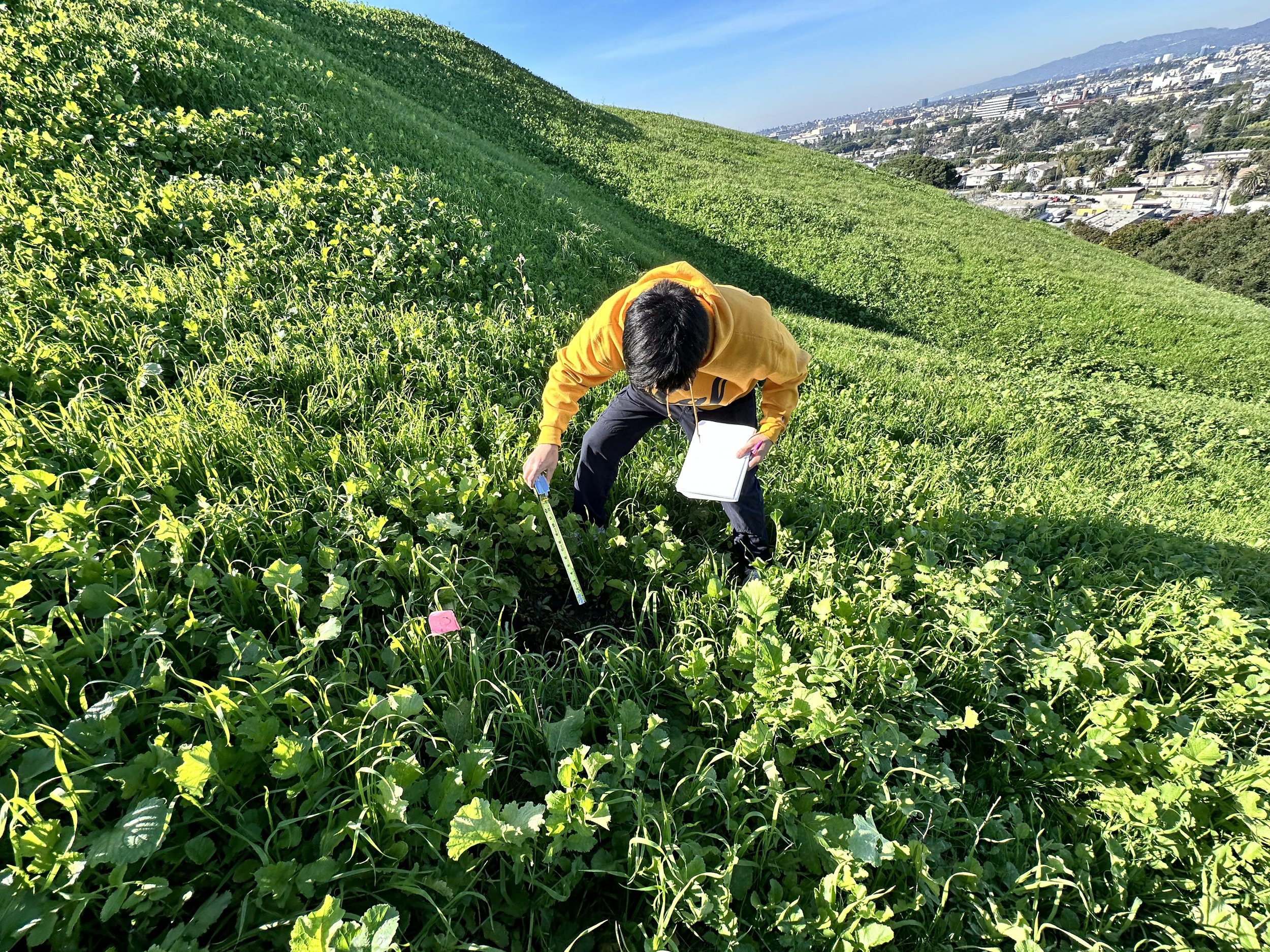Baldwin Hills Greenhouse Program Research Projects, 2022-2023 school year
In May 2023 the Baldwin Hills Greenhouse Program wrapped up its 15th school year. Students did an outstanding job completing habitat restoration and environmental outreach in Baldwin Hills Parklands (and beyond). As they do each year, a core group of students also committed to completing independent projects. They crafted proposals, collected and analyzed data, designed project posters, and spoke about their work in multiple settings. Thematically, projects ranged from plant germination and habitat restoration practices, to nature-based mental health practices and the future of local Ballona Creek. NNI staff leaders are extremely proud of the work that students do in this program. Shared below are the project abstracts and posters.
Jonathan Kim
Ballona Creek – A Case for Environmental Restoration
Urbanization of the local Ballona Creek has resulted in much of the native species and habitats being damaged. Despite this, the creek’s remaining underlying watershed processes allow environmental restoration as a viable solution. My project focuses on creating a justification for why restoring Ballona Creek is necessary. My first two years consisted of conducting surveys and a visualization activity to understand fellow Greenhouse students’ opinions on restoration and depictions of a restored creek as considering the perspectives of youth is crucial for promoting environmental projects. This year, I initially engaged with case studies to research the environmental and community benefits of restoration. Then, I interviewed two sources: Jessica Hall, an LA-based landscape architect, and Deborah Gregory, the President of Ballona Creek Renaissance. Using these interviews and the research I’ve done over the last three years, I created a digital story map using Google Earth to present restoration as a realistic solution, particularly in two locations that can serve as hubs for the community: one near the Culver City schools and the other near Baldwin Hills Scenic Overlook. This story map can serve as a piece to inform the local community and potentially be used for future restoration efforts.
Eddy Ju
Noise Pollution in Baldwin Hills
This research project investigates noise pollution in Baldwin Hills Scenic Overlook by collecting data on sound levels in five key locations and analyzing site characteristics contributing to noise pollution. The research was conducted in five specific areas of Baldwin Hills Scenic Overlook: the entrance of the park, the flat midslope area, the area midway up the road towards the parking lot, the trail near the bathrooms at the top, and the parking lot area, including the entrance to the Stoneview trail. Observations were made regarding the presence of pavement, vegetation height within 20 ft of each location, and slope characteristics. Additionally, sound level measurements were recorded every minute for five minutes in each location using a sound level meter device. After data collection, it was found that areas with paved roads or trails had the highest sound level measurements, as more people and cars tended to pass by on paved surfaces. In contrast, areas with no pavement had the lowest amounts of noise pollution and more natural sounds, such as bird noises. The findings of this research inform people about the importance of considering site characteristics in noise control measures and the idea of developing sustainable practices that minimize noise pollution.
Yusuf Maung and Aryan Punj
Mimicking Nature: Can video media replicate nature effectively?
With the importance of digital media in today's society and the COVID-19 quarantine showcasing that nature will not always be accessible to everyone, it is important to research ways to reduce stress other than relaxing in nature. We did a continuation of our previous project and focused on how video media can be used to deal with mental stress and compared to nature-based activities. Our study group was composed of Greenhouse Program students. Surveys were taken before and after (1) a video media activity on Zoom (2) a nature activity in person at Baldwin Hills Scenic Overlook. Surveys asked participants to report their stress level and their emotional state. Results indicated that our initial hypothesis that video media would have the same level of impact on people's stress and emotion level as nature was not completely supported by the data set. This was a result of many variations and difficulties in the studies. Although our data and findings may be imprecise due to these variations and difficulties regarding the studies it showcases that video media may be able to replicate nature’s impact in reducing stress and improving emotional health.
Diya Punj
How to Build a Healthy Brain
My project is on how to build a healthy brain based on the book How to Build a Healthy Brain by Kimberly Wilson, more specifically focusing on yoga and meditation. Both are mindful activities for taking a break from the world. I wanted to see which one our youth prefers more, yoga or meditation. I used two Youtube videos, one for yoga and another for meditation. These videos were watched on two separate days to avoid getting mixed results. I had everyone in the Baldwin Hills Greenhouse program fill out a pre- and post-survey. The pre-survey showed that people were pretty stressed and not too happy, but after following the videos, the post-survey showed that people felt better. These videos were watched over Zoom, so there was no way for me to see if the videos were actually followed, but considering how the answers weren’t random I trust that they were followed. I believe that people found yoga more enjoyable because yoga is physically engaging, while meditation is much more mindful. To sum things up, if people could take as little as 5 minutes out of their day to practice mindful activities like yoga and meditation, they may feel better and more ready to face challenges.
Adam Kim
Walnut Germination Using Two Methods
This year my project focused on what methods are the best for the germination of the Southern California Black Walnut. We reran our test from last year to confirm our findings, testing to see the effects of Arbuscular Mycorrhizal on the Southern California Black Walnuts germination. Newly this year we tested how viable it was to do a direct seeding method, which is more cost effective. These tests are extremely important because this species of Walnut is endangered and is a large part of the ecosystem in Southern California. I set up 111 cold stratified walnuts in two trays of soil (56 each). I then treated one tray with Arbuscular Mycorrhizal. Each pot contained the same mixture of potting soil, topsoil, and biosol fertilizer. We also selected two sites where we planted 5 groups of 3 seeds per site; they all were equipped with a gopher cage and marking flag. Our findings for the repeat experiment were from the test group 30/56 and the control 32/56 germinated in a testing time of 72 days. Our direct seeding results were very positive, with 24/30 germinating and the other 6 being lost with the test time of 137 days.
Emily Hernandez
Cactus Propagation
My project focuses on the difference in root growth rate between the Prickly Pear and Jumping Cholla cacti species, overall comparing to see which one of the two had a higher success in growth rate based on the root growth. Different elements such as the variation in soil and insects discovered on the Prickly Pears contributed to the discovery of which species had a higher growth. The weather before the experiment was conducted played into effect, the consecutive rainfall loosened up the soil, and certain areas were loamy and sandy. However, in order to execute my experiment, certain cacti were chosen from various parts of the park (harvested as pads on January 22, 2023). We installed 31 jumping Cholla and 23 Prickly Pear pads at a restoration site on March 31, 2023. On May 10, 2023, we then examined 4 Prickly Pear pads and 4 Cholla pads to measure roots. My primary findings revealed that Prickly Pear roots were longer in the sandy soil in comparison to the loamy soil and there was hardly a noticeable difference in root growth rate between the Jumping Cholla. Understanding the relationships between cacti species, root growth rates, and soil type has significant implications for cacti cultivation and conservation efforts. By conducting this experiment future Greenhouse students can optimize these findings, the cultivation techniques, and improve the success rate of cacti propagation.
Bennett Kim
Renovating Systems at the Baldwin Hills Greenhouse
Baldwin Hills used to be a conglomeration of grasslands, wetlands, and marshes however, that was all changed as a result of urbanization (Masters 2012). To help contribute to the restoration of this area I aimed to build a new system of organization for the compost and soil storage area, with the hope of also organizing the gallon pot area along with creating new plant mats out of old hoses. To complete this goal I used a variety of recycled materials like wooden pallets and gallon pots from plant shipments. I was able to complete a majority of this project, fully completing the new soil storage area with a new door/gate that has a plastic siding as well as emptying and flattening the compost area while siding it with plastic from the gallon pots as well. My motivation behind this project was to leave the greenhouse a better place. I aimed to incorporate newer approaches to composting so that we can more efficiently and confidently create compost out of native plants that we know won't spread invasive/non-native species. To restore the Baldwin Hills area into a snapshot of the past environment.
Support for the Greenhouse Program was provided by the California State Parks Foundation Climate Resiliency program, National Fish & Wildlife Foundation, SoCal Urban Wildlife Refuge Project, the Outdoor Equity Grant, and generous donors.
